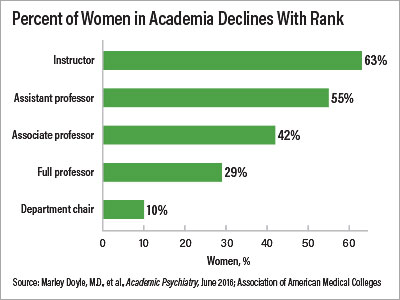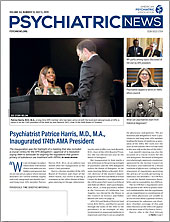Women in the United States have made much progress in medicine since 1849, when the first woman obtained a medical degree. But 170 years later, a wide gender gap persists in compensation, advancement, and research funding, according to presenters at an APA Annual Meeting session on gender bias in academic medicine. Admissions of women to medical schools have more than doubled since the passage of Title IX of the Education Amendments of 1972, which prevents federally funded, higher-learning institutions from discriminating on the basis of gender. In fact, women made up 53% of medical school admissions in 2017 and have accounted for roughly half of residents in psychiatry for the past 20 years.
Despite the strong representation of women psychiatrists in residency training and early career positions, women faculty in tenured or executive leadership positions have not experienced similar gains, said speaker Latoya Frolov, M.D., M.P.H., a fourth-year psychiatry resident at the University of California, San Francisco (UCSF).
“Based on generational changes, seniority, and the number of women in psychiatry, we would expect about one-third of psychiatry department chairs to be women,” Kristen Berendzen, M.D., Ph.D., a fourth-year psychiatry resident at UCSF, told attendees. However, just 10% of psychiatry department chairs are women, and only about 30% of full professors in psychiatry are women (see chart).
Unequal pay is another inequity that women physician faculty including psychiatrists encounter. A 2016 JAMA Internal Medicine study of more than 10,000 physician faculty salaries found that women physicians were on average paid $20,000 less a year, even after researchers adjusted for a variety of other factors, including years since residency completion, faculty rank, specialty, and indicators of productivity such as clinical hours worked. A salary survey of 65,000 full-time physicians by Doximity found that in 2017 women earned $105,000 less on average, even after adjusting for hours worked, geographic location, provider specialty, and years in practice.
Berendzen also cited various studies revealing a gender gap in research funding. For example, a 2012 study found that fewer than one-third of research grants go to women, and the average size of grants awarded to men surpasses those awarded to women.
Among medical students, women face gender bias in their performance evaluations. Berendzen pointed to a study of nearly 90,000 clerkship evaluations from core clinical rotations at two medical schools. Published in May in the Journal of General Internal Medicine, the findings revealed gender-based differences in the language used to evaluate the students, even among students who received the same grade. Evaluations of women students were more likely to include descriptors of personality traits such as “lovely,” while evaluations of male students tended to focus on competency-related attributes such as “scientific” and “knowledgeable.”
Women also continue to experience sexual harassment and discrimination, said Berendzen. A 2018 study in the Journal of General Internal Medicine found that as many as two-thirds of academic women researchers surveyed said they had experienced gender bias or sexual harassment with negative effects on their confidence and career advancement.
“More women than ever are entering medicine, but at all levels of training and practice, they continue to experience harassment and discrimination,” Berendzen said. “The #MeToo and #TimesUP movements have created a platform to challenge inappropriate gender-related treatment in the workplace.”
Another significant issue that women in medicine continue to face is a lack of family-friendly policies in training programs and at work, Berendzen said. “Family-leave policies are not standardized across institutions, and they are discretionary, meaning they are allowed only at the discretion of management or the institution.” Women in psychiatry also cited the absence of mentorships and role models—obstacles reported by women in other areas of medicine as well.
In the spirit of problem-solving, audience members broke into small groups to brainstorm solutions to these issues. They came up with the following ideas:
•
Adopt family-friendly policies. Policies such as allowing part-time and flexible career paths for women could increase women physicians in the workforce. Organizations also could provide at least 12 weeks of fully paid maternity leave, lactation rooms, on-site childcare, and paid sick leave to care for children or elderly family members—responsibilities women are more likely to take on.
•
Require institution-wide managerial training to address implicit or unconscious bias, discrimination, and sexual harassment. Organizations should provide implicit bias training for all managers, and performance evaluations should include feedback on how well managers are providing mentorship, sponsorship, and promotion opportunities for women. “There should be a message for management: Your promotion could be impacted if you don’t mentor or promote women,” one attendee said.
•
Create fair rotation for “housekeeping”-type responsibilities. Women in academic medicine are more likely than men to serve on committees and provide mentorship, activities that may not necessarily help them advance their careers. Several attendees recommended creating a rotation for these responsibilities so the work is more evenly distributed among men and women.
•
Create safe reporting mechanisms for harassment. Organizations should implement third-party reporting systems for sexual harassment or assault so that women can come forward without fearing retribution.
•
Provide networking opportunities for all women. Then APA President Altha Stewart, M.D., who attended the session, pointed out that the head of human resources at her organization hosts a regular support group for all women faculty members so they can network, problem solve together, and encourage senior faculty to mentor women. “When we are together, we are stronger,” said one attendee. ■
“Sex Differences in Physician Salary in U.S. Public Medical Schools” is posted
here. “Differences in Narrative Language in Evaluations of Medical Students by Gender and Under-represented Minority Status” is posted
here. “Eliminating Gender-Based Bias in Academic Medicine: More Than Naming the ‘Elephant in the Room’ ” is posted
here.

